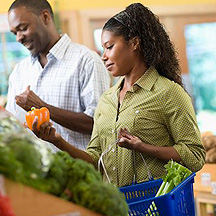Sunday in the Kitchen with Mark and Bruce: Whole-Grain Challah
A handmade bread to ring in the weekend, the Jewish New Year, and a week of great meals.


Sad but true, most of us are all too busy. And true as well, we often only have time to cook on the weekends. That’s when we find ourselves making bread.
No, bread is hardly a meal. And yes, it does seem a little luxurious to spend all that time on bread. But there may be no better way to spend a Sunday afternoon.
To knead the loaf, working with your hands to create your food — it’s the very best way to get connected to what you eat, to feel your food in your bones (even in your fingertips). Invested in your food — quite literally, physically invested in it with bread-making — you’ll find that better choices are easier to make.
Despite the fear many of us have when it comes to bread-making, there’s really not much to it. The yeast does the heavy lifting. Your job is merely to make it so the yeast can succeed. But there’s the rub, what has pulled many of us back from our bread-baking dreams: It’s not always easy to get the atmospherics right. But don’t worry. We’ve got you covered. Here’s how it goes:
1. Warm the mixing bowl. Run warm — not hot — tap water in the bowl, then dry it thoroughly. A warm bowl gives the yeast more freedom to play.
2. Similarly, if you store flour or wheat germ in the refrigerator, bring it to room temperature by setting it out on the counter for several hours (or overnight) before you begin making bread.
3. Make sure the eggs are at room temperature. Chilly eggs will take the edge off the yeast. Set the eggs in their shells on your counter for 15 minutes or submerge them in the shells in a bowl of warm — not hot — tap water for 5 minutes.
4. Figure out the best place for the bread to rise. How about near the heater in your house? Or in a back closet that’s always warm? Or on the kitchen stove, especially if you’ve heated up the burners earlier in the day?
5. Use fresh yeast. Check the expiration date on the packet. If it’s been in your pantry a couple of months, consider buying new.
After that, you’re on your way to the old-fashioned treat of fresh bread. As you probably know, we’re nuts for whole grains, so we’ve morphed a traditional egg-bread recipe into a heartier loaf with whole-wheat flour and toasted wheat germ, both of which give it a firmer texture.
Better yet, your work will pay off all week. We’ve got meals that use the day-old (or older!) bread: an easy bread salad, a slow-cooker breakfast treat, and a hearty gratin for a chilly evening ahead.
So let’s get to it!
About the whole-grain challah
Challah is a Friday-night staple in Jewish homes, the bread of the Sabbath evening meal. It’s also served at Rosh Hashanah, the Jewish New Year, usually in mid-to-late September; the bread is dipped in honey as a symbol of the hope of a sweet New Year. In the end, challah is arguably the best egg bread you can make — tender and light — a great Sunday kitchen project. We’ve renovated the traditional recipe for a sweet and healthy New Year — or just about any meal of the week.
No, bread is hardly a meal. And yes, it does seem a little luxurious to spend all that time on bread. But there may be no better way to spend a Sunday afternoon.
To knead the loaf, working with your hands to create your food — it’s the very best way to get connected to what you eat, to feel your food in your bones (even in your fingertips). Invested in your food — quite literally, physically invested in it with bread-making — you’ll find that better choices are easier to make.
Despite the fear many of us have when it comes to bread-making, there’s really not much to it. The yeast does the heavy lifting. Your job is merely to make it so the yeast can succeed. But there’s the rub, what has pulled many of us back from our bread-baking dreams: It’s not always easy to get the atmospherics right. But don’t worry. We’ve got you covered. Here’s how it goes:
1. Warm the mixing bowl. Run warm — not hot — tap water in the bowl, then dry it thoroughly. A warm bowl gives the yeast more freedom to play.
2. Similarly, if you store flour or wheat germ in the refrigerator, bring it to room temperature by setting it out on the counter for several hours (or overnight) before you begin making bread.
3. Make sure the eggs are at room temperature. Chilly eggs will take the edge off the yeast. Set the eggs in their shells on your counter for 15 minutes or submerge them in the shells in a bowl of warm — not hot — tap water for 5 minutes.
4. Figure out the best place for the bread to rise. How about near the heater in your house? Or in a back closet that’s always warm? Or on the kitchen stove, especially if you’ve heated up the burners earlier in the day?
5. Use fresh yeast. Check the expiration date on the packet. If it’s been in your pantry a couple of months, consider buying new.
After that, you’re on your way to the old-fashioned treat of fresh bread. As you probably know, we’re nuts for whole grains, so we’ve morphed a traditional egg-bread recipe into a heartier loaf with whole-wheat flour and toasted wheat germ, both of which give it a firmer texture.
Better yet, your work will pay off all week. We’ve got meals that use the day-old (or older!) bread: an easy bread salad, a slow-cooker breakfast treat, and a hearty gratin for a chilly evening ahead.
So let’s get to it!
About the whole-grain challah
Challah is a Friday-night staple in Jewish homes, the bread of the Sabbath evening meal. It’s also served at Rosh Hashanah, the Jewish New Year, usually in mid-to-late September; the bread is dipped in honey as a symbol of the hope of a sweet New Year. In the end, challah is arguably the best egg bread you can make — tender and light — a great Sunday kitchen project. We’ve renovated the traditional recipe for a sweet and healthy New Year — or just about any meal of the week.
Whole-Grain Challah
Makes 18 servings
PointsPlus® value | 4 per serving
PointsPlus® value | 4 per serving
Ingredients
- 3/4 cup plus 2 Tbsp warm tap water (about 105°F)
- 1 Tbsp honey
- One 1/4-oz package active dry yeast
- 3 Tbsp almond oil
- 2 large eggs, at room temperature, divided
- 1 tsp salt
- 2 cups bread flour
- 1 1/2 cups whole-wheat flour
- 1/2 cup toasted wheat germ
- Cooking spray
- 2 Tbsp cool tap water
Instructions
- Place warm water, honey and yeast in a large bowl or the large bowl of a stand mixer fitted with dough hook. Stir until honey dissolves. Set aside for 10 minutes until yeast bubbles, is even a little foamy.
- Stir in oil, 1 large egg, 1 large egg yolk, and salt, until egg and egg yolk are broken up. Add both flours and wheat germ; stir or beat at low speed until a stiff dough forms. (If mixture is too dry and crumbly to form a soft dough, stir in more warm water in 1-tablespoon increments until a dough forms.)
- If you’re working by hand, dump dough onto a clean, dry, work surface; knead for 10 minutes. If you’re working with a stand mixer, knead at low speed for 5 minutes, according to manufacturer’s instructions.
- Spray a large bowl with cooking spray. Gather dough into a ball; set it in bowl. Turn dough over, cover bowl with plastic wrap, and set aside in a warm, draft-free place until doubled in bulk, about 1 1/2 hours. When you stick your fingers into the dough, the prints should not spring back.
- Punch down dough; remove it from bowl. Divide dough into three equal pieces. Using palms of your hands, roll each piece into an 18-inch rope, slightly tapered. Lay the three ropes on work surface. Pinch together the three ends at top; braid three strands by pulling one outside (left or right) strand over middle strand (thereby creating a new middle strand), then repeat, alternating left and right sides as you use all the dough. When done, pinch together ends nearest you. Tuck pinched ends under loaf; transfer braid to a parchment-paper-lined baking sheet.
- In a small bowl, whisk remaining egg white and cool water until foamy. Brush loaf with this egg wash. Set aside, uncovered, in a warm, draft-free place until dough rises by about 50 percent (not truly doubled), about 40 minutes.
- Position rack in center of oven; heat oven to 375F. Bake for 20 minutes, or until well browned. A tap on sides of loaf should sound hollow. Cool on baking sheet for 20 minutes, then continue cooling on a wire rack to room temperature. Slice into 3/4-inch-thick slices. Store in a zip-top bag in the refrigerator for up to 3 days — or freeze for up to 4 months.
Serving size: 1 slice
| Sunday-night dinner |
|---|
| Open-faced sandwiches Since the bread will never be this fresh again, offer a variety of toppings for open-faced sandwiches. Try smoked salmon, sliced avocados, sliced tomatoes and lowfat cream cheese, or offer grilled zucchini strips, grilled eggplant rounds and purchased pesto, or have a platter of cold cuts along with antipasto fixings (roasted red peppers, artichoke hearts, olives, etc.). Or do all three — and more! Even PB&Js will never be the same with homemade whole-wheat challah. Tips, hints and suggestions 1. Even though it’s fresh, feel free to toast the challah anyway. You’ll turn it crunchy with a soft, fresh interior — utter bliss! 2. Always use a serrated knife to cut challah. 3. Reseal the bread quickly in the zip-top plastic bag to maintain its freshness for the days to come. |



















